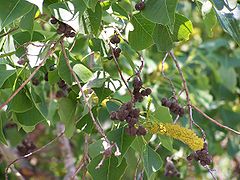Sapium
| Sapium subsp. var. | ||||||||||||||||||||||||||||||||||||||||||||||||||||||||
|---|---|---|---|---|---|---|---|---|---|---|---|---|---|---|---|---|---|---|---|---|---|---|---|---|---|---|---|---|---|---|---|---|---|---|---|---|---|---|---|---|---|---|---|---|---|---|---|---|---|---|---|---|---|---|---|---|

|
|
| ||||||||||||||||||||||||||||||||||||||||||||||||||||||
| ||||||||||||||||||||||||||||||||||||||||||||||||||||||||
Sapium is a plant genus of the family Euphorbiaceae, comprising about 125 species. The genus is native to the Tropics, especially the Neotropics. These species have been historically cultivated as a seed-oil crop for soap production and other tallow product, hence the name Sapium.
| Standard Cyclopedia of Horticulture |
|---|
|
Sapium (the Latin name used by Pliny for a resiniferous pine). Euphorbiaceae. Tropical trees and shrubs cultivated for their economic products and sometimes for ornament. Glabrous: juice milky and poisonous: lvs. alternate or rarely opposite, simple, denticulate to entire; stipules small, 2 conspicuous glands at the apex of the petiole and on each of the scale-like bracts: fls. generally in terminal spikes, the pistillate singly below, the staminate in 3's above, all apetalous; calyx of staminate fls. 2-3-lobed, the lobes imbricate; stamens 2-3, filaments free; ovary 1-3-celled, 1 ovule in each cell; a 3-parted central column remaining after dehiscence of the caps.: seed without a caruncle.—Nearly 100 species, in the tropics of both hemispheres, but chiefly in Amer. Two intro. species are now found wild in S. Fla. Related to Stillingia, Hura, and Homalanthus. In their native country a number of species of Sapium are utilized in many ways. They are chiefly important as a source of rubber. S. Jenmanii is the chief source of rubber in British Guiana, where it is found in the alluvial forests in humid situations. It does best in well-drained clayey peat. S. verum, once common in Colombia, has been cut for the rubber until it is now rare, but does well under cultivation in higher altitudes, yielding ten to eighteen pounds of raw rubber to each tree. A number of other species are used for rubber in South America. S. Pavonianum yields a medium grade. It is easily grown but is scarcely in cultivation. S. sebiferum is cultivated, especially in China, for the wax of the seed-covering which is used for candles, soap, and cloth-dressing. The wood of this and other species is utilized. Some of the "jumping beans" are seeds of sapium which contain insect larvae. Sapium may be propagated by seeds or by cuttings. The best varieties are sometimes top-grafted on seedling stocks. Among the species noted for their very poisonous juice are: S. indicum, Wild., with white bark and oblong willow-like lvs., in India, and S. Hippomane, Mey., Milk Tree, Poison Tree, with thick elliptical lvs. with the apex cucullate inflexed. W. Indies to Brazil. CH
|
Cultivation
Propagation
Pests and diseases
Species
About 125. Species include:
- Sapium aubrevillei
- Sapium aucuparium
- Sapium bolivianum
- Sapium bourgeaui
- Sapium biloculare, Mexican jumping bean
- Sapium glandulatum
- Sapium haematospermum
- Sapium harrisii
- Sapium jamaicense
- Sapium japonicum
- Sapium laurocerasum
- Sapium longifolium
- Sapium luzonicum
- Sapium montevidense
- Sapium saltense
- Sapium sebiferum, Chinese tallow
- Sapium sellowianum
- Sapium triloculare
Gallery
References
- Standard Cyclopedia of Horticulture, by L. H. Bailey, MacMillan Co., 1963
